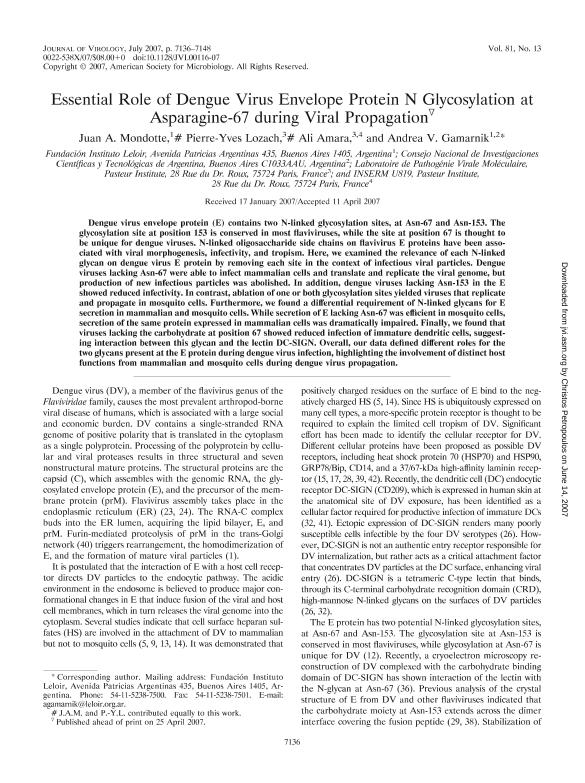Artículo
Essential Role of Dengue Virus Envelope Protein N-Glycosylation at Asparagine-67 During Viral Propagation
Fecha de publicación:
07/2007
Editorial:
American Society for Microbiology
Revista:
Journal of Virology
ISSN:
0022-538X
e-ISSN:
1098-5514
Idioma:
Inglés
Tipo de recurso:
Artículo publicado
Clasificación temática:
Resumen
Dengue virus envelope protein (E) contains two N-linked glycosylation sites, at Asn-67 and Asn-153. The glycosylation site at position 153 is conserved in most flaviviruses, while the site at position 67 is thought to be unique for dengue viruses. N-linked oligosaccharide side chains on flavivirus E proteins have been associated with viral morphogenesis, infectivity, and tropism. Here, we examined the relevance of each N-linked glycan on dengue virus E protein by removing each site in the context of infectious viral particles. Dengue viruses lacking Asn-67 were able to infect mammalian cells and translate and replicate the viral genome, but production of new infectious particles was abolished. In addition, dengue viruses lacking Asn-153 in the E showed reduced infectivity. In contrast, ablation of one or both glycosylation sites yielded viruses that replicate and propagate in mosquito cells. Furthermore, we found a differential requirement of N-linked glycans for E secretion in mammalian and mosquito cells. While secretion of E lacking Asn-67 was efficient in mosquito cells, secretion of the same protein expressed in mammalian cells was dramatically impaired. Finally, we found that viruses lacking the carbohydrate at position 67 showed reduced infection of immature dendritic cells, suggesting interaction between this glycan and the lectin DC-SIGN. Overall, our data defined different roles for the two glycans present at the E protein during dengue virus infection, highlighting the involvement of distinct host functions from mammalian and mosquito cells during dengue virus propagation
Archivos asociados
Licencia
Identificadores
Colecciones
Articulos(IIBBA)
Articulos de INST.DE INVEST.BIOQUIMICAS DE BS.AS(I)
Articulos de INST.DE INVEST.BIOQUIMICAS DE BS.AS(I)
Citación
Mondotte, Juan Alberto; Lozach, Pierre Yves; Amara, Ali; Gamarnik, Andrea Vanesa; Essential Role of Dengue Virus Envelope Protein N-Glycosylation at Asparagine-67 During Viral Propagation; American Society for Microbiology; Journal of Virology; 81; 13; 7-2007; 7136-7148
Compartir
Altmétricas




